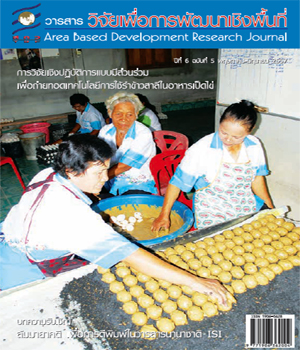ผลการประเมินสถานการณ์ปัญหา และการจัดการดัชนีลูกน้ำยุงลาย โดยผสมผสานวิธีและการมีส่วนร่วมของชุมชน เพื่อเตรียมความพร้อมในการแก้ปัญหาโรคไข้เลือดออกของ ตำบลกำแพงเซา จังหวัดนครศรีธรรมราช
Main Article Content
Abstract
การศึกษาครั้งนี้เป็นงานวิจัยเชิงพรรณนาที่มีการเก็บข้อมูลแบบผสมผสานวิธี และประยุกต์ใช้วิธีวิทยาวิจัยเชิงปฏิบัติการแบบมีส่วนร่วมของชุมชน มีวัตถุประสงค์เพื่อประเมินสถานการณ์ปัญหา อุปสรรคความต้องการ การจัดการข้อมูลดัชนีลูกน้ำยุงลาย และการประเมินความพร้อมในการแก้ปัญหาโรคไข้เลือดออกของชุมชนอย่างยั่งยืน ในพื้นที่ 9 หมู่บ้านของตำบลกำแพงเซา จังหวัดนครศรีธรรมราช กลุ่มอาสาสมัครที่เข้าร่วมวิจัยประกอบด้วยแกนนำชุมชนจาก อบต. กำแพงเซา แกนนำ อสม. จาก 9 หมู่บ้าน ผู้ใหญ่บ้าน ผู้ช่วยผู้ใหญ่บ้าน เจ้าหน้าที่สาธารณสุข และตัวแทนครัวเรือน เครื่องมือในประเมินสถานการณ์เชิงคุณภาพประกอบด้วย การประชุมเชิงปฏิบัติการ การสนทนากลุ่ม การฝึกทักษะการสำรวจและเก็บรวบรวมข้อมูล การประชุมนำเสนอข้อมูล และการระดมสมองเพื่อร่วมวางแผนดำเนินงาน ส่วนประเมินสถานการณ์เชิงปริมาณ ประกอบด้วย แบบประเมินสิ่งแวดล้อมครัวเรือน แบบประเมินความรู้เบื้องต้นเกี่ยวกับการป้องกันควบคุมโรคไข้เลือดออก แบบประเมินความรู้การจัดการดัชนีลูกน้ำยุงลาย และข้อมูลอัตราการป่วย และอัตราการป่วยตายของโรคไข้เลือดออก ตลอดถึงวิเคราะห์ระบบการจัดการดัชนีลูกน้ำยุงลายในช่วง 1 ปีที่ผ่านมา วิเคราะห์ข้อมูลอุปสรรคและความต้องการจากการประชุมและสนทนากลุ่มโดยใช้วิธีวิเคราะห์เนื้อหาส่วนการวิเคราะห์ข้อมูลเชิงปริมาณใช้วิธีสถิติเชิงพรรณนา และวิเคราะห์ค่าดัชนีลูกน้ำยุงลายด้วยอัตราร้อยละ
การดำเนินการวิจัยแบ่งเป็น 3 ขั้นตอนคือ 1) ขั้นการเตรียมความพร้อมชุมชนและแกนนำชุมชนจำนวน 45 คน 2) ขั้นดำเนินการประเมินสถานการณ์ปัญหาจากข้อมูลอัตราป่วย สำรวจสภาพแวดล้อมครัวเรือน อุปสรรค และความต้องการจากตัวแทนครัวเรือน 1,761 คน การประเมินความรู้เบื้องต้นเกี่ยวกับโรคไข้เลือดออกจำนวน 150 คน และประเมินความรู้การจัดการดัชนีลูกน้ำยุงลายจำนวน 113 คน ประชุมและสนทนากลุ่มเกี่ยวกับการจัดการดัชนีลูกน้ำยุงลาย และการสังเกตสิ่งแวดล้อม และ 3) ขั้นวิเคราะห์ข้อมูลและประชุมเสนอข้อมูลคืนแก่ชุมชน
ผลการดำเนินการ พบว่า 1) ชุมชนยังคงมีความเสี่ยงสูงต่อการระบาดของโรคไข้เลือดออกแม้ว่าจะมีการดำเนินการแก้ปัญหาโรคไข้เลือดออกอย่างต่อเนื่องถึง 5 ปี โดยอัตราป่วยของแต่ละหมู่บ้านปี พ.ศ. 2555 อยู่ในช่วง 79.8 ถึง 783 รายต่อแสนประชากร ทั้งนี้เนื่องด้วยบริบทสภาพแวดล้อมของชุมชนเกษตรกรรมสวนยางพาราและสวนผลไม้ การเดินทางเข้าออกจากชุมชนกับชุมชนอื่นๆ ระบบน้ำประปา ไม่ทั่วถึงทำให้มีภาชนะเก็บน้ำทั้งในและนอกบ้าน โดยจะพบภาชนะน้ำใช้ในและนอกบ้านเฉลี่ย 1.61 และ 1.38 จำนวนชิ้นต่อบ้าน 1 หลังตามลำดับ 2) อุปสรรคในการแก้ปัญหามี 3 ด้านได้แก่ สิ่งแวดล้อมของชุมชนที่เอื้อต่อการเกิดยุงลาย เจ้าหน้าที่ของรัฐขาดความรับผิดชอบ และความร่วมมือของประชาชนยังน้อยมาก 3) ความต้องการของชุมชนมี 3 ประเด็นได้แก่ การทำงานของเจ้าหน้าที่ต้องจริงจัง การให้ความรู้แก่ชุมชน และการใช้สารเคมีที่ถูกต้อง 4) การจัดการดัชนีลูกน้ำยุงลายไม่ครอบคลุมพื้นที่ ขาดความต่อเนื่อง การวิเคราะห์ผล และการนำข้อมูลการสำรวจไปใช้ประโยชน์ไม่มีความชัดเจน ทั้งนี้ อสม. มีความรู้เกี่ยวกับการจัดการดัชนีลูกน้ำยุงลายในข้อความหมายและการคำนวณ ค่าดัชนี BI HI และ CI เพียงร้อยละ 6.2 และ 2.7 ตามลำดับ สำหรับการประเมินความรู้เบื้องต้นเกี่ยวกับการป้องกันและควบคุมโรคไข้เลือดออกพบว่าตอบได้ถูกต้องมากกว่าร้อยละ 80 ทุกข้อ และ 5) ชุมชนมีความพร้อมในการแก้ปัญหาที่เหมาะสมกับสถานการณ์ปัญหาและบริบทของชุมชนเมื่อได้รับคืนข้อมูลการประเมินสถานการณ์
The Results of Problem Situation and Larval Indices Management Assessment Based on Mixed Method and Community Participation Approach for Preparing the Dengue Problem Solution in KumpheangSou Sub-district, Nakhon Si Thammarat Province
This study design was mixed method of collecting data and applied community participation approach. The objectives were to assess the situation of dengue problem, barrier, needs, larval indices management, and community preparation of nine villages in KumpheangSou sub-district, Nakhon Si Thammarat province. Participants were consisted of representatives of Local Administrative Organization, Village Health Volunteer (VHV), community leader, assistant community leader, Health provider, and household. Qualitative assessment tools were consisted of workshop, group discussion, collecting data training, presentation meeting, and brain storming for planning intervention. Otherwise, quantitative techniques were household’s environment assessment tool; basic’s knowledge of dengue prevention and control; knowledge of Aedesegypti larval indices management; and dengue morbidity and mortality rate. Moreover, larval indices management system was analyzed as secondary data. Data analysis techniques were content analysis technique for qualitative data, descriptive statistic analysis for quantitative data, and percentage analysis for larval indices rate.
The research was conducting on three steps such as: 1) community preparationstep was 45 representatives of all stakeholders in community; 2) situation assessment step were 1,761 household’s environment assessment, 150 VHVs for basic’s knowledge of dengue prevention and control, and 113 VHVs for knowledge of larval indices management assessment; and 3) analysis and data feedback to community step.
The results found that: 1) the community has been solving dengue problem more than five years, but it was high risk of dengue outbreak in the community. Especially in 2013, morbidity rate in 79.8 to 783 per 100,000 populations. So that, the problem was related environment factors such as agriculture area, transportation, and lack of water pipeline, then average of water containers in house and outdoor 1.61 and 1.38 pieces per house; 2) barrier for solving problem showed: household’s environment for supporting vector breeding, government official lack of the role, and people in community lack of participation; 3) community’s needs showed: seriouslyworking of government official, dengue education program for community, and understanding for using chemical; 4) larval indices management system was uncovering areas, non continuing, unpresenting analyzing data, and less utilizing the results of larval indices survey; VHVs lacked of knowledge of Aedesegypti larval indices such as identify the meaning and computed of larval indices (BI,HI, and CI) were 6.2% and 2.7% as step. Basic’s knowledge of dengue prevention and control of VHVs were corrected answer all items; and 5)feedback data step found the community was preparing for solving dengue problem.
Article Details
Area Based Development Research Journal values copyright protection and licensing to safeguard author rights and facilitate the appropriate dissemination of research. Our policies ensure openness, accessibility, and attribution. Authors retain copyright ownership, and articles are published under a Creative Commons Attribution License (CC BY), allowing sharing, adaptation, and proper attribution. Authors have the freedom to publish under the CC BY license, granting broad reuse and distribution permissions. The journal supports posting articles on third-party repositories, adhering to institutional and funding restrictions. Author guidelines detail copyright and licensing requirements, empowering authors with knowledge about their rights and responsibilities. These policies cultivate an environment of collaboration, openness, and responsible sharing, benefiting authors and the research community while honoring intellectual property rights.


